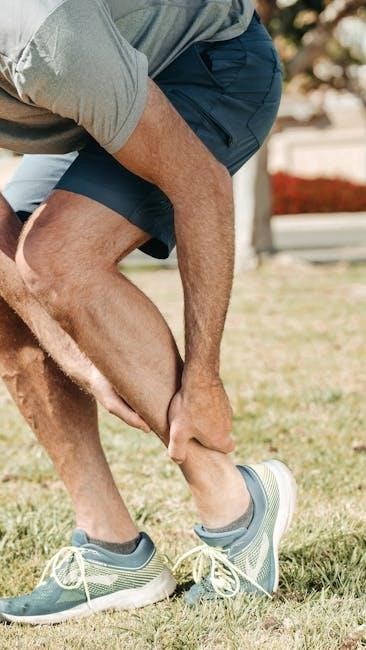
sciatica pain stretches pdf
Sciatica refers to pain radiating from the low back into the buttocks, hips, and legs due to sciatic nerve irritation․ Symptoms include numbness, tingling, and burning sensations․ Stretching exercises are a highly effective way to alleviate sciatica pain and promote long-term healing․ Downloadable PDF guides provide detailed stretch routines and visual aids to help manage symptoms effectively․
1․1 Understanding Sciatica and Its Symptoms
Sciatica is a common condition characterized by pain radiating along the path of the sciatic nerve, which runs from the lower back through the hips and down each leg․ Symptoms often include sharp or shooting pain, numbness, tingling, and muscle weakness․ These sensations typically affect one side of the body and can range from mild discomfort to debilitating pain․ Understanding these symptoms is crucial for effective management and relief, especially when incorporating stretching exercises into your routine․
1․2 The Importance of Stretching for Sciatica Relief
Stretching is a highly effective way to alleviate sciatica pain by reducing pressure on the sciatic nerve․ Regular stretching improves flexibility, strengthens surrounding muscles, and enhances blood flow to the affected areas․ It can also reduce muscle tension and discomfort, making it easier to perform daily activities․ Stretching is a low-risk, cost-effective method that can be done at home, making it a cornerstone of sciatica management․ Consistent practice helps prevent future flare-ups and promotes long-term relief․

Causes and Symptoms of Sciatica
Sciatica arises from irritation of the sciatic nerve, often due to herniated discs, spinal stenosis, or piriformis syndrome․ Symptoms include lower back pain, leg numbness, and tingling․
2․1 Common Causes of Sciatica
Sciatica typically results from compression or irritation of the sciatic nerve, often caused by a herniated disc, degenerative disc disease, or spinal stenosis․ Piriformis syndrome, where the piriformis muscle tightens and presses on the nerve, is another common cause․ Spondylolisthesis, a condition where a vertebra slips out of place, can also trigger sciatica․ Less frequently, sciatica may stem from direct injuries, infections, or tumors affecting the nerve․ Understanding these causes is crucial for targeted relief and treatment․
2․2 Identifying Sciatica Symptoms
Sciatica symptoms often include sharp, shooting, or burning pain radiating from the lower back down the buttocks and legs․ Tingling, numbness, or weakness in the affected areas are common․ Pain typically worsens with prolonged sitting, coughing, or sneezing․ It may also cause difficulty moving or standing comfortably․ Symptoms vary depending on the nerve’s compression point․ In severe cases, loss of reflexes or bladder/bowel control can occur․ Accurate identification of these symptoms is essential for proper diagnosis and effective treatment․

Benefits of Stretching for Sciatica
Stretching alleviates sciatica pain, enhances flexibility, and relaxes tight muscles․ Regular stretching improves posture, reduces inflammation, and strengthens core muscles, promoting long-term sciatica management and overall well-being․
3․1 How Stretching Relieves Sciatica Pain
Stretching targets tight muscles that compress the sciatic nerve, such as the piriformis․ By loosening these muscles, stretching reduces nerve pressure, alleviating pain and discomfort․ Improved blood flow and reduced muscle spasms further enhance relief․ Gentle movements promote spinal alignment, easing nerve irritation․ Regular stretching also strengthens weak muscles, providing better support and reducing strain on the lower back․ This combination of effects creates a therapeutic approach to managing sciatica symptoms effectively, offering both immediate and sustained pain relief․
3․2 Long-Term Benefits of Regular Stretching
Regular stretching enhances flexibility, reducing muscle stiffness and improving range of motion․ It strengthens core and pelvic muscles, providing better spinal stability and minimizing nerve irritation․ Over time, stretching prevents muscle imbalances that exacerbate sciatica․ Consistent practice also improves posture, reducing strain on the lower back․ Long-term benefits include reduced recurrence of pain, enhanced overall physical fitness, and improved mental well-being by managing chronic discomfort․ Incorporating stretching into daily routines fosters a proactive approach to sciatica management, promoting a healthier, pain-free lifestyle․

Effective Sciatica Stretches
This section explores effective stretches targeting the lower back, glutes, and hamstrings to alleviate sciatica pain and improve flexibility for long-term relief․
4․1 Figure 4 Stretch for Piriformis Muscle
The Figure 4 Stretch targets the piriformis muscle, often implicated in sciatica pain․ Lie on your back, cross one ankle over the opposite knee, forming a “4” shape․ Gently pull the unaffected leg toward your chest until a stretch is felt in the buttock․ Hold for 20-30 seconds and repeat 2-3 times on each side․ This stretch alleviates tension in the piriformis, reducing pressure on the sciatic nerve and providing relief from pain and discomfort․ Regular practice enhances flexibility and reduces sciatica flare-ups․
4․2 Cat-Cow Stretch for Spinal Mobility
The Cat-Cow Stretch improves spinal mobility and relieves sciatica pain by gently flexing and extending the spine․ Start on your hands and knees in a tabletop position․ Inhale as you arch your back, lifting your head and tailbone (Cow Pose)․ Exhale as you round your spine, tucking your chin and pelvis (Cat Pose); Repeat for 10-15 breaths․ This stretch enhances flexibility, reduces stiffness, and promotes blood flow, helping to ease sciatica discomfort while strengthening core muscles․ Regular practice supports long-term spinal health and pain relief․

4․3 Seated Sciatic Nerve Floss
The Seated Sciatic Nerve Floss targets the sciatic nerve, improving mobility and reducing irritation․ Sit with legs extended straight․ Slowly bend forward from the hips, keeping knees slightly bent, until a gentle stretch is felt in the back of the leg․ Hold for 20-30 seconds, then return to the starting position․ Repeat 5-10 times․ This stretch helps relieve numbness, tingling, and pain caused by nerve compression․ Regular practice enhances nerve flexibility and improves circulation, providing lasting sciatica relief․ Perform gently to avoid aggravation․
4․4 Single Knee to Chest Stretch
The Single Knee to Chest Stretch targets the lower back and hip area․ Lie on your back with knees bent and feet flat․ Bring one knee toward your chest, holding onto it gently with your hands․ Hold for 20-30 seconds, then slowly lower it back down․ Repeat 3 times on each side․ This stretch relieves tension in the lower back and hips, improving spinal flexibility and reducing sciatica discomfort․ It’s a gentle, effective stretch for daily practice to maintain mobility and alleviate pain․
4․5 Child’s Pose for Lower Back Relief
Child’s Pose is a gentle stretch that provides relief to the lower back and hips․ Start on your hands and knees, then sit back onto your heels․ Stretch your arms forward, lower your forehead to the ground, and relax your body․ Hold for 20-30 seconds, breathing deeply․ This pose gently stretches the spinal muscles, alleviating sciatica pain and tension․ Regular practice can improve flexibility and reduce discomfort in the lower back region, making it an excellent addition to your daily routine for sciatica relief․
4․6 Lower Trunk Rotation Stretch
The Lower Trunk Rotation Stretch targets the muscles in the lower back and hips, providing relief from sciatica pain․ Lie on your back with knees bent and feet flat on the floor․ Hug one knee toward your chest and gently rotate your trunk to the opposite side, holding for 20-30 seconds․ Repeat on the other side․ This stretch improves spinal flexibility and reduces tension in the lower back, helping to alleviate sciatica discomfort when performed regularly․
4․7 Bridge Stretch for Glutes and Lower Back
The Bridge Stretch is an effective exercise for alleviating sciatica pain by targeting the glutes and lower back․ Lie on your back with knees bent and feet flat on the floor․ Engage your core, then lift your hips toward the ceiling, squeezing your glutes at the top․ Hold for 5-10 seconds before lowering back down․ This stretch strengthens the glutes, stabilizes the lower back, and reduces pressure on the sciatic nerve, providing significant relief when done consistently․ Incorporate 10-15 repetitions for maximum benefit․
4․8 Hamstring Stretch for Leg Flexibility

The Hamstring Stretch targets tight hamstrings, often contributing to sciatica pain; Sit on the floor with your affected leg straight and the other leg bent․ Lean forward from your hips until you feel a stretch in the back of your thigh․ Hold for 15-30 seconds, then release․ Repeat 2-3 times per leg․ This stretch improves leg flexibility and reduces hamstring tightness, which can alleviate sciatica discomfort․ Avoid bouncing and stop if pain occurs beyond a gentle stretch․

Modifications and Safety Considerations
Always consult a healthcare professional before starting stretches, especially if pregnant or experiencing severe pain․ Begin slowly, avoid aggravating movements, and modify stretches as needed for comfort․
5․1 Sciatica Stretches During Pregnancy
During pregnancy, sciatica stretches must be modified for safety․ Consult a healthcare provider before starting․ Gentle stretches like the Cat-Cow or Seated Sciatic Nerve Floss can relieve discomfort․ Avoid deep twists or movements that compress the abdomen․ Use a pillow for support and perform stretches on a soft surface․ Stop if pain worsens․ Focus on strengthening core and pelvic muscles to alleviate pressure on the sciatic nerve․ Listen to your body and seek professional guidance for personalized modifications․
5․2 Avoiding Aggravating Movements
To manage sciatica, avoid movements that worsen pain, such as heavy lifting, sudden twists, or repetitive bending․ Sitting for long periods can also aggravate symptoms․ Replace high-impact exercises with low-impact alternatives like swimming or cycling․ Use proper posture and ergonomics to reduce strain․ Avoid crossing legs or standing on one side, as this can compress the sciatic nerve․ Take regular breaks to stretch and move gently․ Prioritize activities that promote spinal alignment and avoid overexertion to prevent flare-ups․
5․3 Tips for Safe Stretching Practices
Ensure safe stretching by listening to your body and avoiding pain․ Breathe deeply and naturally, avoiding bouncing or forcing stretches․ Warm up with gentle movements before stretching․ Focus on controlled, slow movements to prevent muscle strain․ Use props like cushions or straps if needed for support․ Avoid stretching cold muscles, as this can increase injury risk․ Stop immediately if pain occurs and consult a professional․ Cool down gradually to relax muscles and improve flexibility․ Prioritize proper technique to maximize benefits and minimize risks․

Creating a Daily Stretching Routine
Start with short, manageable sessions and gradually increase duration․ Focus on consistency, aiming for daily practice․ Incorporate a mix of stretches targeting key muscle groups․ Set realistic goals and track progress to stay motivated․ Begin slowly, allowing your body to adapt, and prioritize proper form․ Maintain a calm environment to enhance focus and relaxation during stretching․ Consistency is key for long-term relief and improved flexibility․
6․1 How to Structure Your Daily Routine
Begin with gentle warm-up stretches to prepare muscles․ Focus on core exercises to stabilize the lower back․ Incorporate specific sciatica stretches, holding each for 20-30 seconds․ Allow rest days to avoid overexertion․ Adjust intensity based on pain levels and progress․ Prioritize proper breathing and posture throughout․ End with a cool-down to relax muscles․ Track your routine to ensure consistency and make adjustments as needed․ A well-structured routine promotes gradual improvement and prevents aggravation of symptoms․
6․2 Duration and Frequency of Stretches
Hold each stretch for 20-30 seconds to allow muscles to relax․ Repeat stretches 2-3 times for optimal relief․ Aim for 2-3 stretching sessions daily, especially after activities that trigger sciatica pain․ Start with shorter durations if pain is severe, gradually increasing as comfort improves․ Consistency is key, but avoid overexertion․ Listen to your body and adjust frequency based on progress and discomfort levels․ Balancing regular practice with rest ensures sustainable improvement without aggravating symptoms․

When to Seek Professional Help
Seek professional help if sciatica pain persists beyond 4-6 weeks, worsens, or causes severe numbness, tingling, or weakness․ Consult a specialist if symptoms interfere with daily activities or if conservative treatments fail to provide relief․
7․1 Signs That You Need Medical Attention
If you experience severe sciatica pain that interferes with daily activities, seek medical help․ Red flags include intense numbness, tingling, or weakness in the legs, difficulty walking, or loss of bladder/bowel control․ If pain worsens despite stretching and conservative treatments, consult a healthcare professional․ Persistent symptoms lasting more than six weeks or unexplained pain also warrant medical evaluation to rule out serious conditions like nerve damage or spinal issues․
7․2 Consulting a Physical Therapist
A physical therapist specializes in addressing sciatica pain through targeted exercises and manual therapy․ They create personalized plans to strengthen weak muscles and improve mobility․ If stretching alone doesn’t relieve pain, a physical therapist can incorporate modalities like heat, ice, or ultrasound․ Consulting a therapist is especially beneficial for chronic cases or when pain persists after home stretches․ They can also identify underlying issues and prevent future flare-ups, ensuring a comprehensive approach to managing sciatica․

Additional Resources for Sciatica Relief
Explore downloadable PDF guides and video tutorials for sciatica stretches․ These resources provide visual demonstrations and detailed instructions to enhance your stretching routine effectively․
8․1 Downloadable PDF Guides for Sciatica Stretches
Downloadable PDF guides offer comprehensive step-by-step instructions for sciatica stretches․ These guides often include illustrations, exercise routines, and safety tips․ They are ideal for home use, providing clear guidance on proper techniques to relieve sciatica pain․ Many PDFs are free or low-cost, making them accessible to everyone․ They can be printed or saved on devices for easy reference․ These resources help users maintain consistency in their stretching routines, ensuring long-term relief from sciatica symptoms and improving overall lower back health effectively․
8․2 Recommended Exercise Videos and Tutorials
Exercise videos and tutorials provide visual guidance for performing sciatica stretches correctly․ Platforms like YouTube and specialized fitness websites offer a wide range of instructional content․ These videos often feature physical therapists demonstrating stretches, ensuring proper form and technique․ Many tutorials cater to different fitness levels, making them accessible to everyone․ They also include tips for creating a daily routine and tracking progress․ By following these videos, individuals can enhance their stretching practice and achieve effective relief from sciatica pain while staying motivated and informed․
9․1 Summary of Key Points
Stretching is a highly effective way to alleviate sciatica pain by improving flexibility, reducing muscle tension, and enhancing spinal mobility․ Consistent practice of targeted stretches, such as the Figure 4, Cat-Cow, and Seated Sciatic Nerve Floss, can provide significant relief․ It’s important to perform stretches gently and avoid aggravating movements․ For sustained benefits, incorporate stretching into your daily routine and maintain proper posture․ If pain persists or worsens, consult a healthcare professional․ Regular stretching, combined with lifestyle adjustments, can help manage sciatica effectively and improve overall well-being․ Download a sciatica pain stretches PDF guide for easy reference․
9․2 Encouragement for Consistent Practice
Consistency is key to managing sciatica pain effectively․ Regular stretching helps strengthen muscles, improve flexibility, and reduce discomfort over time․ Even small, daily efforts can lead to significant long-term relief․ Stay motivated by tracking progress, celebrating milestones, and reminding yourself of the benefits․ Incorporate stretches into your routine, like those found in a sciatica pain stretches PDF, and remain committed to your well-being․ With patience and dedication, you can achieve lasting relief and enhance your quality of life․